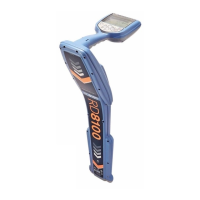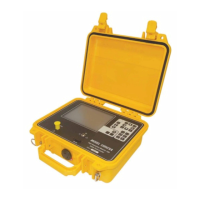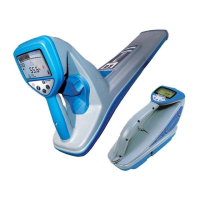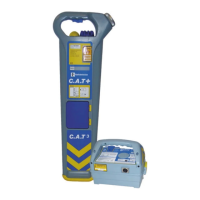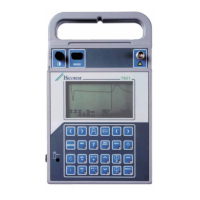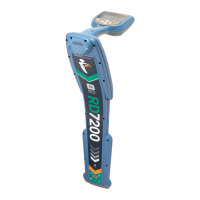PCMx Operation Manual
© 2021 Radiodetection Ltd 33
Interpreting
Result
This section provides an overview of interpreting
results generated by the PCMx Locator.
8.1 Introduction
The principle of the PCMx is that the frequency used is so
low (4Hz) that the effects of induced and capacitance
coupling to other lines are reduced to almost zero. Also
natural decay of the signal due to these effects is also
reduced to almost zero.
The losses are due completely to resistive losses i.e.
coating defects or contact to other structures.
8.2 Avoiding errors
Always use the standard techniques to ensure
measurements are valid. Confirm that peak bar graph
and null arrows coincide. If in doubt check for field
distortion by taking a depth reading and then raise the
locator a known height, for example 0.5m, and confirm
the depth measurement increases by the corresponding
amount.
As the PCMx uses such a low frequency the sources of
error are much reduced. However, there are still certain
circumstances that will create errors.
8.3 Identifying Interference
Errors due to locate (ELF/LF) signal distortion can result in
errors in 4Hz current measurement. This is because the
4Hz current measurement process relies on depth as
measured by the ELF or LF signal.
Poor Peak and Null locate, outside 15cm (6 inch)
maximum.
Unreasonable depth measurement.
Reading on the LCD bargraph not stable.
Possible causes of Interference
Parallel pipes.
Too close to transmitter. Tie-ins, T-junctions and
L bends.
Measurements at Ts, bends, abrupt changes in depth etc.
should be avoided, as there will always be a degree of field
distortion at these points.
Taking readings too close to large parked
vehicles, moving vehicles, boots or shoes with
steel toe-caps or large metal structures.
Taking readings near to PCMx Transmitter and
anode cables or anode ground bed.
Measurements taken near the transmitter anode bed or
earth stake can be misleading. This is because all the
signal current passes through the earth stake or anode
bed. The signal ground currents close to the transmitter
are therefore significant and opposite to the pipe current.
The effect is that for the first 30 to 50 meters – and
depending on ground conditions – the measured current
may increase. In fact, the current on the pipe is probably
at a constant level.
If it is necessary to survey this section of pipe it will be
necessary to apply the transmitter at a different location
and work back to this point.
8.4 Locate current
In ELF – and with a locate reading current below
15mA – the PCMx readings will not be accurate.
In LF – and with a locate reading current below 2mA
– the PCMx reading will not be accurate.
8.5 PCMx Current
PCMx current results depend on locate current. If the
PCMx current has fallen below 100mA on a long survey, it
is likely that the locate current is also low. It is possible to
obtain results by using a portable transmitter nearby to
provide a locate signal. Use a different frequency from the
PCMx Transmitter locate frequency.
8.6 Interpreting survey results
Taking a classical situation as shown in Figure 8.1, graph ‘A’
shows the ideal response which is a loss of signal current
and a step response, but excludes any effects from fault
currents in the ground.

